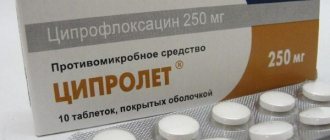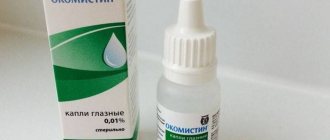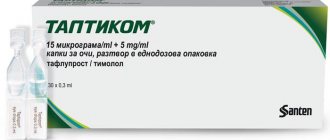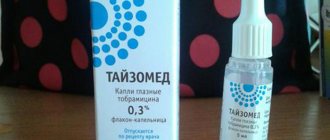Mechanism of action of the drug
Levofloxacin is a fluoroquinolone antibiotic that is effective and easily tolerated by patients. The remedy is widely used as it has a universal spectrum of action. It acts locally and destroys pathogenic microflora that are involved in inflammatory processes.
Levofloxacin works like this: it enters the DNA of bacteria and stops the synthesis of nucleic acids. After this, they die due to structural changes in the membranes, cytoplasm and cell wall.
Microorganisms such as gram-positive and gram-negative bacteria, anaerobes, atypical and mycobacteria are sensitive to this drug. There is no sensitivity to this drug in spirochetes.
Levofloxacin is distinguished by good penetration into all tissues of the body. The highest content of the active substance in the organs is achieved 2 hours after application. It is excreted from the body through the excretory system with urine.
Levofloxacin
The drug is a fluoroquinolone, a broad-spectrum antimicrobial bactericide. Blocks DNA gyrase (topoisomerase II) and topoisomerase IV, disrupts supercoiling and cross-linking of DNA breaks, suppresses DNA synthesis, causes profound morphological changes in the cytoplasm, cell wall and membranes of bacteria.
In vitro activity:
Microorganisms sensitive to the drug (minimum inhibitory concentration less than 2 mg/l).
Aerobic gram-positive microorganisms: Corynebacterium diphtheriae, Enterococcus spp. (including Enterococcus faecalis), Listeria monocytogenes, Staphylococcus spp. (coagulase-negative methicillin-sensitive/moderately sensitive strains), including Staphylococcus aureus (methicillin-sensitive strains), Staphylococcus epidermidis (methicillin-sensitive strains), Staphylococcus spp. (leukotoxin-containing); Streptococcus spp. groups C and G, Streptococcus agalactiae, Streptococcus pneumoniae (penicillin-sensitive/moderately sensitive/resistant strains), Streptococcus pyogenes, Streptococcus viridans group (penicillin-sensitive/resistant strains).
Aerobic gram-negative microorganisms: Acinetobacter spp. (including Acinetobacter baumannii), Actinobacillus actinomycetemcomitans, Citrobacter freundii, Eikenella corrodens, Enterobacter aerogenes, Enterobacter agglomerans, Enterobacter spp. (including Enterobacter cloacae), Escherichia coli, Gardnerella vaginalis, Haemophilus ducreyi, Haemophilus influenzae (ampicillin-sensitive/resistant strains), Haemophilus parainfluenzae, Helicobacter pylori, Klebsiella spp. (including Klebsiella oxytoca, Klebsiella pneumoniae), Moraxella catarrhalis (beta-lactamase producing and non-producing strains), Morganella morganii, Neisseria gonorrhoeae (penicillinase producing and non-producing strains), Neisseria meningitidis, Pasteurella spp. (including Pasteurella canis, Pasteurella dagmatis, Pasteurella multocida), Proteus mirabilis, Proteus vulgaris, Providencia spp. (including Providencia rettgeri, Providencia stuartii), Pseudomonas spp. (including Pseudomonas aeruginosa), Serratia spp. (including Serratia marcescens), Salmonella spp.
Anaerobic microorganisms: Bacteroides fragilis, Bifidobacterium spp., Clostridium perfringens, Fusobacterium spp., Peptostreptococcus spp., Propionibacterium spp., Veilonella spp.
Dr. microorganisms: Bartonella spp., Chlamydia pneumoniae, Chlamydia psittaci, Chlamydia trachomatis, Legionella spp. (including Legionella pneumophila), Mycobacterium spp. (including Mycobacterium leprae, Mycobacterium tuberculosis, Mycoplasma hominis), Mycoplasma pneumoniae, Rickettsia spp., Ureaplasma urealyticum.
Moderately sensitive microorganisms (minimum inhibitory concentration more than 4-8 mg/l):
Aerobic gram-positive microorganisms: Corynebacterium urealyticum, Corynebacterium xerosis, Enterococcus faecium, Staphylococcus epidermidis (methicillin-resistant strains), Staphylococcus haemolyticus (methicillin-resistant strains).
Aerobic gram-negative microorganisms: Burkholderia cepacia, Campylobacter jejuni, Campylobacter coli.
Anaerobic microorganisms: Bacteroides thetaiotaomicron, Bacteroides vulgatus, Bacteroides ovatus, Prevotella spp., Porphyromonas spp.
Resistant microorganisms (minimum inhibitory concentration more than 8 mg/l):
Aerobic gram-positive microorganisms: Corynebacterium jeikeium, Staphylococcus aureus (methicillin-resistant strains), other Staphylococcus spp. (coagulase-negative methicillin-resistant strains).
Aerobic gram-negative microorganisms: Alcaligenes xylosoxidans.
Dr. microorganisms: Mycobacterium avium.
Composition and release form
The composition of Levofloxacin contains the active substance levofloxacin hemihydrate and the following auxiliary components:
- microcrystalline cellulose;
- polysorbate 80;
- calcium stearate;
- croscarmellose sodium;
- hypromellose.
The release form of Levofloxacin, which is used for sinusitis, depends on the severity of the disease. The appointment is made by an otolaryngologist. Before prescribing this medication, he determines the degree of infection of the maxillary sinuses.
There is a tablet form of the drug, a suspension for oral administration, and an injection for parenteral administration.
Dosages are available in the form of tablets of 250 and 500 mg. They are yellow in color and have a convex shape. Produced in dies of 5 or 10 pieces. The injections are available in containers of 100 and 500 ml, where 1 ml of liquid contains 5 mg of the active substance.
See also
Use and dosage of Doxycycline for adults for sinusitis
Read
Levofloxacin: instructions for use
The drug Levofloxacin in tablet form is taken orally. Each tablet must be taken with water. It is best to take the medicine immediately before a meal.
The tablet should not be chewed. Usually, when prescribing therapy with this drug, doctors recommend taking it no more than twice a day.
Levofloxacin infusion solution provides a strong therapeutic effect in the treatment of many diseases. It is administered intravenously by drip at a slow pace. The duration of administration should not be more than 60 minutes.
The maximum volume of the administered drug is 100 ml . Procedures are carried out 1-2 times during the day. The decision to replace therapy with Levofloxacin solution by taking the drug orally without changing the dosage can be made only if the patient’s condition improves.
When choosing a dose, as well as the duration of therapy with Levofloxacin, the doctor must first of all take into account the severity of the disease found in the patient, take into account the nature of the developing infection and take into account the sensitivity of the pathogen that provoked the disease.
If the patient’s renal function is normal or moderately reduced, then when creatinine is below 50 ml/min, it is recommended to prescribe the dosage of the drug in the form of tablets and infusion solution in the following regimen:
- For sinusitis, the drug is prescribed once a day with a dosage of 500 mg. The duration of treatment with tablets should be 10–14 days.
- In case of exacerbation of bronchitis, which occurs in a chronic form, the drug is prescribed once a day. The patient should take tablets in a dosage of 250 or 500 mg. The duration of therapy is usually 7–10 days.
- For urinary tract diseases of infectious etiology, the drug is prescribed once a day at a dosage of 250 mg. The duration of the course of therapy varies from 7 to 10 days.
If creatinine is more than 50 ml/min, the dosage of the drug should be reduced , and the intervals between administration of the drug should be increased. For those patients who have impaired liver function, dose adjustment is not required.
Therapy is carried out for 78 hours until the patient’s body temperature normalizes or after confirmation of recovery is received by laboratory tests.
Use of Levofloxacin eye drops
The drug Levofloxacin in the form of eye drops is used topically in the treatment of ophthalmic diseases. It is instilled into the conjunctival sac, maintaining a dosage of 1-2 drops in each affected eye.
Typically, the following treatment regimens are used to treat eye diseases using this medicine: the first two days of therapy, the medicine is instilled every 2 hours 8 times a day . From the third to the seventh days of treatment, drops are instilled every 4 hours, 4 times a day.
The drug in the form of drops is not recommended to be taken for more than seven days. If several medications prescribed by an ophthalmologist are used together, then an interval of 15 minutes . To avoid contamination of the solution, do not touch the tissue around the eye and eyelids with the tip of the dropper.
Contraindications
Each drug that is present on the pharmacological market has certain contraindications. Levofloxacin also has restrictions on its use. Contraindications are indicated in the instructions for this medication:
- high sensitivity to the drug;
- renal failure;
- epilepsy;
- tendon damage;
- age under 18 years;
- pregnancy.
Treatment of sinusitis with levofloxacin
Sinusitis can be of different types and shapes. Therefore, the doctor must first refer the patient for an examination, with the help of which he will find out the cause of the disease. Sinusitis happens:
- Viral.
- Gribkov.
- Allergic.
- Bacterial.
- Traumatic.
- Mixed.
The form of sinusitis can be acute or chronic. For bacterial etiology, the doctor prescribes an antibiotic. Often this is Levofloxacin. If the disease is mild, then adults take 1 tablet 250/500 mg twice a day, the duration of the course is 10 days. They should be washed down with liquid without chewing. For severe disease, the dose is 500 mg. The number of doses of the drug depends on the doctor's prescription.
Levofloxacin is absorbed equally well whether it is taken before or after meals. Once ingested, it enters the skin, bones and organ systems. Excretion time by the kidneys is within 48 hours. Since it almost does not penetrate the liver tissue, doctors often prescribe it to treat patients with pathologies of this organ.
In the form of injections and solutions, Levofloxacin is used in accordance with the instructions. If a dropper is placed with this drug, then for intravenous administration it is diluted with sodium chloride.
Levofloxacin, despite its effectiveness, is not the drug of choice when it comes to sinusitis. Doctors prescribe it when there is hypersensitivity to antibacterial drugs - cephalosporins, penicillins, macrolides. Or if their impact is low in effectiveness.
Levofloxacin-Solopharm eye drops 0.5% 5ml
Pharmacodynamics
Levofloxacin is the L-isomer of the racemic drug substance ofloxacin.
The antibacterial activity of ofloxacin relates mainly to the L-isomer. As an antibacterial drug of the fluoroquinolone class, levofloxacin blocks DNA gyrase (topoisomerase II) and topoisomerase IV, disrupts supercoiling and cross-linking of DNA breaks (deoxyribonucleic acid), suppresses DNA synthesis, causes profound morphological changes in the cytoplasm, cell wall and membranes.
Mechanism of resistance development
Resistance to levofloxacin can develop primarily through two main mechanisms, namely: a decrease in the intracellular concentration of the drug or changes in the targets of the drug. Changes in the targets of the two bacterial enzymes DNA gyrase and topoisomerase IV are the result of mutations in the chromosomal genes encoding DNA gyrase ( gyrA
and
gyrB )
and topoisomerase IV
(pa r C
and
parE
,
grlA
and
grlB
in Staphylococcus aureus).
Drug resistance due to low intracellular concentration develops as a result of changes in the porin channel system of the outer cell membrane, which leads to a decrease in fluoroquinolone entry into gram-negative bacteria, or from efflux pumps. Efflux-mediated resistance has been described in pneumococci ( PmrA
), staphylococci
( NorA
), anaerobic and gram-negative bacteria.
Plasmid-mediated quinolone resistance (defined by the qnr )
has been found against Klebsiella pneumoniae and Escherichia coli. The development of cross-resistance between fluoroquinolones is possible. Single mutations may not lead to clinical resistance, but multiple mutations cause clinical resistance to all drugs in the fluoroquinolone class. Alterable outer membrane porins and efflux systems can have broad substrate specificity, affecting multiple classes of antibacterial agents and leading to multiple resistance.
Its effectiveness against gram-positive aerobes - Enterococcus faecalis - has been established in vitro and confirmed in clinical studies. Staphylococcus aureus (methicillin-sensitive strains), Staphylococcus epidermidis (methicillin-sensitive strains), Staphylococcus saprophyticus, Streptococcus pneumoniae (including multi-resistant strains - MDRSP), Streptococcus pyogenes, gram-negative aerobes - Enterobacter cloacae, Escherichia coli, Haemophilus influenzae, Haemophilus paraintluenzae , Klebsiella pneumoniae, Legionella pneumophila, Moraxella catarrhalis, Proteus mirabilis, Pseudomonas aeruginosa, Serratia marcescens and other microorganisms - Chlamydia pneumoniae, Mycoplasma pneumoniae. For the majority (90%) of strains of the following microorganisms, minimum inhibitory concentrations of levofloxacin (2 μg/ml or less) have been established in vitro, however, the effectiveness and safety of the clinical use of levofloxacin in the treatment of infections caused by these pathogens has not been established in adequate and well-controlled studies: gram-positive aerobes - Staphylococcus haemolyticus, Streptococcus (group C/F), Streptococcus (group G), Streptococcus agalactiae, Streptococcus milleri. Streptococcus viridans, gram-negative aerobes - Acinetobacter lwoffii, Acinetobacter baumannii, Bordetella pertussis, Citrobacter (diversus) koseri, Citrobacter freundii, Enterobacter aerogenes, Enterobacter sakazakii, Klebsiella oxytoca, Morganella morganii, Pantoea (Enterobacter) agglomerans, Proteus vulgaris, Providencia re ttgeri, Providencia stuartii , Pseudomonas fluorescens, gram-positive anaerobes - Clostridium perfringens.
Sensitive microorganisms: aerobic gram-positive microorganisms -
Corynebacterium diphtheriae, Enterococcus spp., including Enterococcus faecalis, Listeria monocytogenes, Staphylococcus spp.
(coagulase-negative methicillin-sensitive/leukotoxin-containing/moderately sensitive strains), including Staphylococcus aureus (methicillin-sensitive strains), Staphylococcus epidermidis (methicillin-sensitive strains), Streptococcus spp. groups C and G, Streptococcus agalactiae, Streptococcus pneumoniae (penicillin-sensitive/moderately sensitive/resistant strains), Streptococcus pyogenes, Streptococcus spp. viridans group (penicillin-sensitive/resistant strains), aerobic gram-negative microorganisms -
Acinetobacter spp., including Acinetobacter baumannii, Acinetobacillus actinomycetecomitans, Citrobacter freundii, Eikenella corrodens, Enterobacter spp., including Enterobacter aerogenes, Enterobacter agglomerans, Enterobacter cloacae, Escherichia coli, Gardnerella vaginalis, Haemophilus ducreyi, Haemophilus influenzae (ampicillin-sensitive/resistant strains), Haemophilus parainfluenzae, Helicobacter pylori, Klebsiella spp., including Klebsiella oxytoca, Klebsiella pneumoniae, Moraxella catarrhalis (beta-lactamase producing and non-producing strains ) , Morganella morganii, Neisseria gonorrhoeae (penicillinase-producing and non-penicillinase-producing strains), Neisseria meningitidis, Pasteurella spp., including Pasteurella canis, Pasteurella dagmatis, Pasteurella multocida, Proteus vulgaris, Providencia spp., including Providencia rettgeri, Providencia stuartii, Pseudomonas spp., including Pseudomonas aeruginosa, Serratia spp., including Serratia marcescens, Salmonella spp.,
anaerobic microorganisms -
Bacteroides fragilis, Bifidobacterium spp., Clostridium perfringens, Fusobacterium spp., Peptostreptococcus spp., Propionibacterium spp., Veilonella spp. .,
other microorganisms
- Bartonella spp., Chlamydia pneumoniae, Chlamydia psittaci, Chlamydia trachomatis, Legionella pneumophila, Legionella spp., Mycobacterium leprae, Mycobacterium tuberculosis, Mycoplasma hominis, Mycoplasma pneumoniae. Rickettsia spp., Ureaplasma urealyticum.
Moderately sensitive microorganisms (MIC more than 4 mg/l): aerobic gram-positive microorganisms
— Corynebacterium urealyticum, Corynebacterium xerosis, Enterococcus faecium.
Staphylococcus epidermidis (methicillin-resistant strains), Staphylococcus haemolyticus (methicillin-resistant strains), aerobic gram-negative microorganisms -
Burkhoideria cepacia, Campylobacter jejuni, Campylobacter coli,
anaerobic microorganisms
- Bacteroides thetaiotaomicron, Bacteroides vulgatus, Bacteroides ovatus, Prevotella spp. , Porphyromonas spp.
Resistant microorganisms (MIC more than 8 mg/ml): aerobic gram-positive microorganisms -
Corynebacterium jeikeium, Staphylococcus aureus (methicillin-resistant strains), other Staphylococcus spp.
(coagulase-negative methicillin-resistant strains), aerobic gram-negative microorganisms -
Alcaligenes xylosoxidane,
other microorganisms
- Mycobacterium avium.
Minimum inhibitory concentrations of levofloxacin for certain microorganisms
| Microorganism | Sensitive, mg/ml | Resistant, mg/ml |
| Pseudomonas spp. | 1 | >,2 |
| Staphylococcus spp. | 1 | >,2 |
| Streptococcus | 1 | >,2 |
| Streptococcus pneumoniae | 1 | >,2 |
| Haemophilus influenzae | 1 | >,1 |
| Moraxella catarrhalis | 1 | >,2 |
The in vitro activity of levofloxacin is approximately 2 times higher than that of ofloxacin against representatives of Enterobacteriaceae, Pseudomonas aeruginosa and gram-positive microorganisms.
In the case of using levofloxacin in the treatment of chlamydial diseases of the organs of vision, concomitant therapy is required.
The degree of sensitivity of microorganisms to levofloxacin may have significant geographical differences.
The maximum concentration of levofloxacin achieved using 0.5% eye drops is more than 100 times the minimum inhibitory concentration (MIC) of levofloxacin for sensitive microorganisms.










